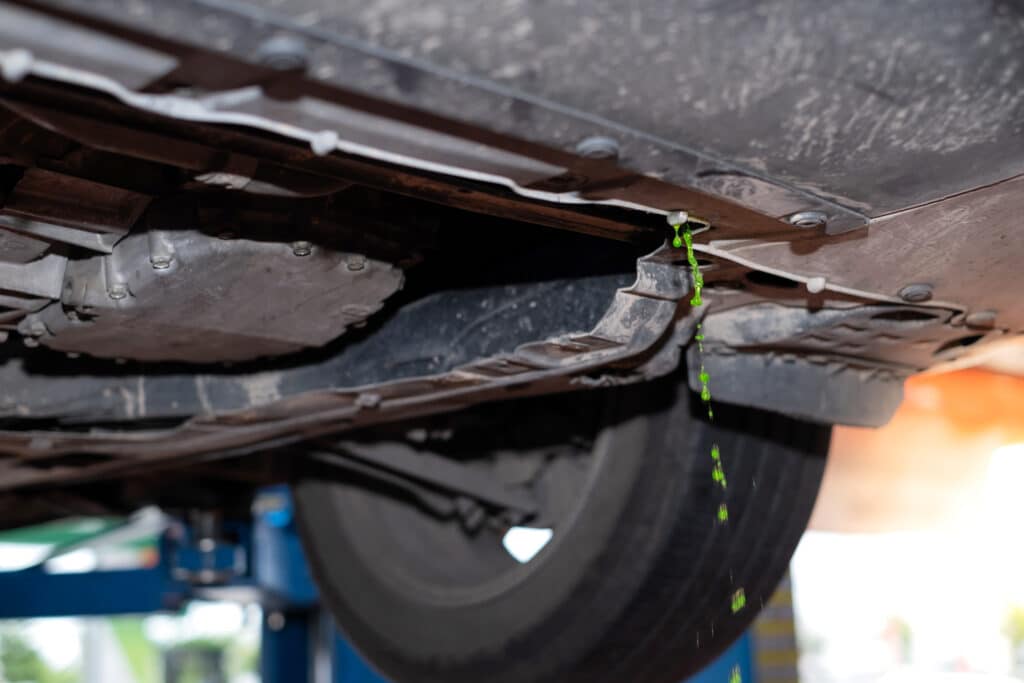A coolant leak on the car, also known as a radiator leak, can quickly lead to serious problems. As the name implies, cooling water has the task of cooling the engine of a car. If the cooling of the engine can no longer be guaranteed, severe damage to the engine may occur.
Potential causes of a coolant leak in the car
In the event of a radiator leak, there are usually two main scenarios that occur frequently. A distinction is made here on the basis of the visibility of the loss of coolant, as this gives an indication of the cause of the loss of coolant.
Cooling water loss with leakage
On the one hand, there is a visual loss of cooling water. This means that it can be seen externally on the engine that the car is losing cooling water. In most cases, a visual loss of coolant is related to a coolant hose leak, a water pump leak or a radiator leak.
Cooling water loss without leakage
On the other hand, the car may lose coolant, although this is not visually visible. This means that the coolant is lost into the engine itself.
If this is the case, the EGR cooler is often leaking or the cylinder head gasket is defective. The coolant is then burned with the combustion of the engine.

Can I loose coolant without having a leak?
In general, the answer here is clearly no! This is because the coolant system is a closed system where no liquid should leak. Nevertheless, coolant can be lost without causing a problem.
The reason is that modern vehicles sometimes use connectors made of plastic to transport the coolant. Therefore, it may happen that a small amount of coolant escapes through the connector.
If the coolant level is too low, however, it needs specific checking to see if there is a major leak.
Fixing a coolant leak using “radiator stop leak”
Radiator stop leak is a product designed to stop leaks in a car’s cooling system. It is typically used to seal small leaks in the radiator, heater core, and other parts of the cooling system. The product works by circulating through the cooling system and filling small holes and cracks with a sealant, which then hardens and stops the leak.
Some products are designed to be added directly to the radiator, while others are added to the coolant reservoir. It is important to follow the instructions on the product carefully, as overuse or misuse can cause damage to the engine or cooling system.
While a radiator stop leak can be a quick fix for a minor leak, it is not a permanent solution. If you have a significant leak or other cooling system issue, it is best to have it repaired it.
What are the symptoms of a coolant leak?
Some symptoms already help to better isolate the cause of the coolant loss. The most common error patterns include the following:
Coolant leaking from bottom of car or from the engine
If the coolant is already visible in the engine compartment because you can see the coolant running along the engine or it is already dripping onto the floor, there is a visual loss of coolant. This means that a coolant hose may be defective (coolant hose leak), for example, due to a marten bite or due to age/material fatigue. Another common cause here is the water pump leak, where the seal is leaking. After replacing the defective component, the loss of coolant should be eliminated.
Oil in the coolant expansion tank
If engine oil is present in the coolant expansion tank, this is the worst possible type of coolant leak. This scenario strongly indicates that the cylinder head gasket is defective, there is a crack in the engine block or in the cylinder head. To find the cause of the fault here, the engine must usually be disassembled down to the cylinder head gasket.
No visual loss of the coolant
If there is no visual coolant leak, troubleshooting is a little more difficult. In most cases, the problem in modern vehicles is a leaking EGR cooler. Here, coolant is forced into the vehicle’s intake along with it, causing the coolant to burn.
Also, in this case, the cylinder head gasket may be defective.
Other symptoms of a coolant leak
- Illumination of the coolant indicator light
- According to the temperature display in the vehicle’s speedometer, the engine is getting too hot
- White smoke from the exhaust of the vehicle when driving or stationary
- In some cases, the check engine light comes on.

